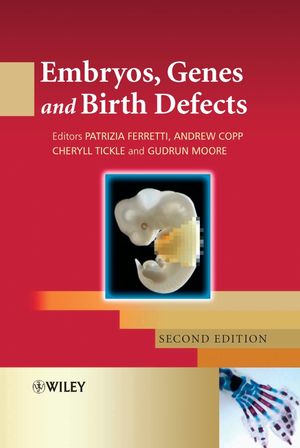Embryos, Genes and Birth Defects, 2nd EditionISBN: 978-0-470-09010-7
Hardcover
512 pages
May 2006
 This is a Print-on-Demand title. It will be printed specifically to fill your order. Please allow an additional 10-15 days delivery time. The book is not returnable.
|
||||||
Preface to the Second Edition.
Contributors.
1.1. 1. The Relationship between Genotype and Phenotype: Some Basic Concepts (Philip Stanier and Gudrun Moore).
Introduction.
The relationship between genotype and phenotype.
The role of ‘model systems’.
The changing concept of homology.
2. Uses of Databases in Dysmorphology (Michael Baraitser).
What is a syndrome?.
Some of these problems are addressed by dysmorphology databases.
Where databases do not help.
Dysmorphology databases.
How databases work.
3. Human Cytogenetics (J. D. A. Delhanty).
Introduction.
Population cytogenetics.
Structural anomalies.
The genesis of chromosome abnormalities.
Embryo survival.
The cause of high levels of chromosome abnormality in human embryos.
Relative parental risks – age, translocations, inversions, gonadal and germinal mosaics.
4. Identification and Analysis of Genes Involved in Congenital Malformation Syndromes (Peter J. Scambler).
Gene identification.
Biological analysis of genes implicated in birth defect syndromes.
Animal models.
Why study rare human birth defect syndromes?.
5. Transgenic Technology and Its Role in Understanding Normal and Abnormal Mammalian Development (Valerie Vidal and Andreas Schedl).
Introduction.
Transgenic mice.
Genetic manipulation using gene targeting in ES cells.
Outlook and future developments.
6. Chemical Teratogens: Hazards, Tools and Clues (Nigel A. Brown) (with revisions by Cheryll Tickle).
Introduction.
Teratogens and human malformations.
General strategy in chemical teratogenesis.
Valproic acid.
Gene–teratogen interaction.
Teratogens and phenocopies.
Teratogens as manipulative tools.
Teratogens as clues.
Final comments.
7. The Limbs (Patrizia Ferretti and Cheryll Tickle).
Developmental anatomy of the human limb.
Main classes of limb defects.
Contemporary studies on mechanisms of limb development.
Limb regeneration.
How, when and where experimental studies elucidate abnormal development.
Agenda for the future.
8. Brain and Spinal Cord Andrew J. Copp.
Introduction.
Overview of nervous system development.
Defects of CNS development: towards a genetic and developmental understanding.
Agenda for the future.
9. Birth Defects Affecting the Eye (Jane C. Sowden).
The eye.
Development of the eye.
Congenital eye defects and paediatric blindness.
Gene mutations underlying congenital eye defects.
Cellular and molecular mechanisms affecting eye development and how they elucidate the causes of abnormal development.
Agenda for the future.
10. The Ear (Sarah Spiden and Karen P. Steel).
Introduction.
Development of the outer and middle ear.
Development of the inner ear.
Main classes of ear defects.
Mechanisms involved in development of the outer and middle ear.
Mechanisms underlying inner ear development.
Mechanisms underlying development of inner ear sensory epithelia.
Mechanisms involved in endolymph homeostasis.
The future.
11. Development of the Enteric Nervous System in Relation to Hirschsprung’s Disease (Heather M. Young, Donald F. Newgreen and Alan J. Burns).
Introduction.
Anatomy and function of the ENS.
The best-characterized developmental defect of the ENS – Hirschsprung’s disease.
Cell biology of ENS development.
Molecular biology of ENS development and Hirschsprung-like dysplasias.
HSCR: current and future treatments.
Conclusions.
12. The Head (Gillian M. Morriss-Kay).
Introduction.
Developmental anatomy.
Main classes of craniofacial defect.
Cellular and molecular mechanisms.
Agenda for the future.
13. The Heart (Deborah Henderson, Mary R. Hutson and Margaret L. Kirby).
Developmental anatomy.
Major cell populations needed for heart development.
Molecular regulation of heart development.
Cardiovascular defects.
The Future.
14. The Skin (Ahmad Waseem and Irene M. Leigh).
Introduction.
Developmental anatomy.
Main classes of skin defects.
Future perspectives.
15. The Vertebral Column (David Rice and Susanne Dietrich).
Introduction.
Developmental anatomy of the vertebral column.
Making the vertebral column.
Agenda for the future.
16. The Kidney (Paul J. D. Winyard).
Introduction.
Structure and function.
Developmental anatomy of nephrogenesis.
Transcription factors.
Growth factors and their receptors.
Survival/proliferation factors.
Cell adhesion molecules.
Other molecules.
Non-genetic causes of renal malformations.
Agenda for the future.
17. The Teeth (Irma Thesleff).
Developmental anatomy.
Main classes of defects.
Cellular and molecular mechanisms affecting development.
How cellular and molecular developmental mechanisms assist in elucidating the causes of abnormal development.
Agenda for the future.
Index.



